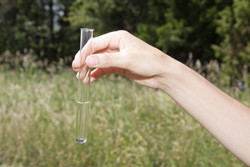New universal microarray for freshwater pathogen testing
Most pathogens are small and occur in low numbers, making them very difficult to measure directly. Moreover, climate change and mass migration from Africa and Asia are expected to alter the ecological balance, likely causing the re-emergence of water-related pathogens. To cope with the changing situation, Europe needs to implement a reliable system for the sensitive, early detection of waterborne pathogens and toxins. The EU-funded μAQUA (Universal microarrays for the evaluation of fresh-water quality based on detection of pathogens and their toxins) project developed a universal microarray chip to detect microbes, including bacteria, viruses, protozoa and cyanobacteria. Water quality was assessed using certain diatoms as bioindicators of ecological status. The designed molecular probes were spotted on microchips that were subjected to several rounds of hybridisation experiments using fluorescently labelled nucleic acids obtained from pure cultures of the target microorganisms. These were either RNA directly extracted from the microorganisms or DNA amplicons obtained after amplification by polymerase chain reaction in the case of DNA. Valid probers were retained and spotted on the so-called generation-3 microarray. This microarray was used for the analysis of the RNA extracted from environmental samples collected from fresh, brackish, marine and drinking water from different locations in six countries (Bulgaria, France, Germany, Ireland, Italy and Turkey). Traditional methods for detecting them are time consuming and labour intensive, and require a highly trained work force. μAQUA responded to this challenge by developing a very sensitive, cost-efficient and simple to use universal microchip array for detecting microbes and toxins. Accurate and efficient water testing will enable a rapid response by water management authorities and producers, thereby improving the quality and safety of European water supplies. In addition, the large body of data obtained will yield important information regarding gene flow and distribution of pathogenic species.
Keywords
Microarray, freshwater, pathogen, drinking water, toxins, bioindicators

